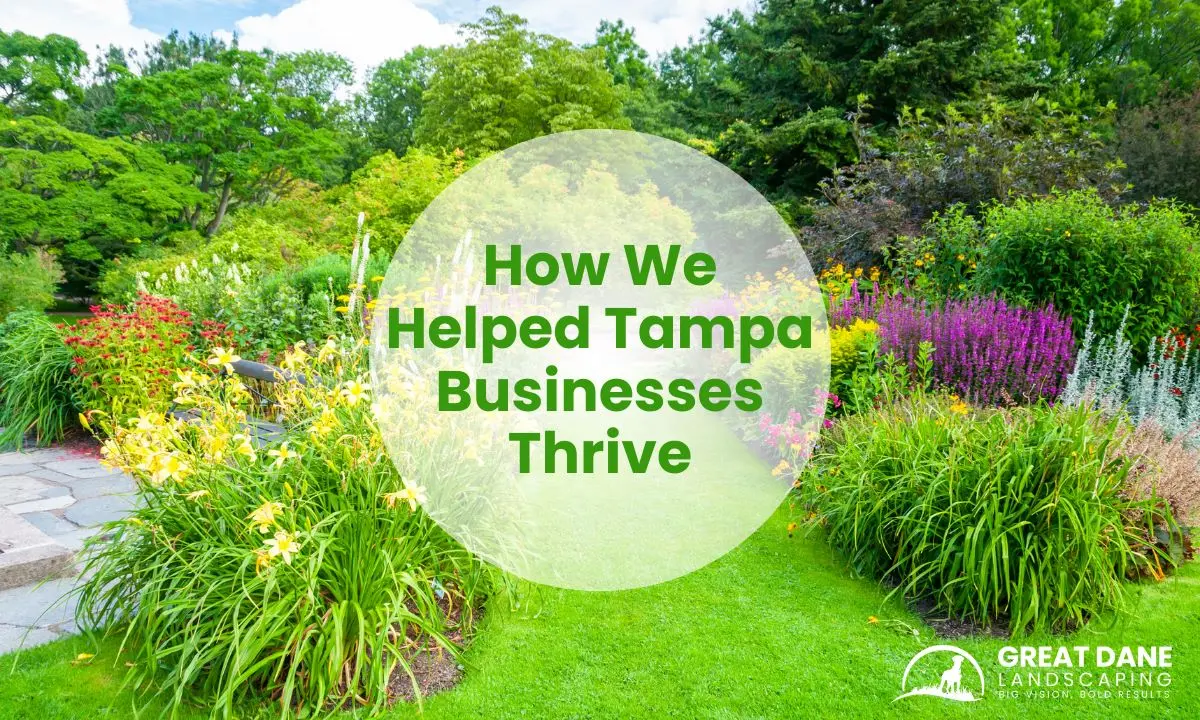Eco-Friendly Landscaping That Works: How We Helped Tampa Businesses Thrive

When the sun dips low over Tampa Bay and the air finally cools, most business owners are winding down their laptops, not worrying about thirsty lawns or patchy turf. But imagine this: you step outside your storefront at dusk, and instead of a dull, brown perimeter, you’re greeted by lush greenery, vibrant flowering shrubs, and pathways that whisper sustainability.
That was the scene one summer evening when we first sat down with Coastal Café conflicted between wanting a show-stopping facade and needing to keep costs, water use, and environmental impact in check.
From Brown to Bloom: A Tampa Transformation
Coastal Café’s owner, Maria, had tried every traditional turf solution under the Florida sun. By mid-June, her “low-maintenance” grass was anything but it demanded daily watering, specialized fertilizers, and constant care.
Yet foot traffic remained flat, and the café’s curb appeal was more “meh” than memorable. That’s when she reached out to Go Great Dane Landscaping for an eco-friendly landscaping overhaul that wouldn’t break the bank.
We began by auditing water usage, soil health, and sun exposure across the property. Maria’s budget was tight, but her vision was grand: an inviting, sustainable oasis where customers could sip coffee under the shade of native trees, surrounded by pollinator-friendly blooms.
Challenges We Faced
- Florida’s Heat and Humidity: High daytime temperatures and humid nights put pressure on delicate plantings.
- Water Restrictions: Local ordinances capped irrigation to just twice a week during the summer months.
- Budget Constraints: Maria needed an affordable landscaping plan that balanced upfront installation costs with long-term savings.
Our Eco-Friendly Solutions
- Native Drought-Tolerant Plants: We selected coontie, muhly grass, and red salvia—species that thrive in sandy soil with minimal irrigation.
- Drip Irrigation System: Precision watering reduced runoff by 40% and delivered moisture straight to root zones.
- Permeable Pavers: Natural stone walkways let rainwater seep into the ground, replenishing the aquifer instead of heading to storm drains.
- Mulch and Organic Amendments: A two-inch layer of shredded cedar mulch helped retain soil moisture while suppressing weeds.
Results That Speak Volumes

Within eight weeks, Coastal Café’s outdoor seating area looked like an eco-tourism brochure. Rainwater percolated through the pavers, the drip lines kept roots happy, and the native plants burst into vibrant color. By fall:
- Water Usage Dropped 35% compared to the previous year.
- Foot Traffic Increased 22% as patrons discovered the café’s new al fresco charm.
- Maintenance Costs Fell 18% thanks to low-input plantings and efficient irrigation.
Beyond One Café: A Broader Impact
Word travels fast in Tampa’s tight-knit business community. Soon, property managers and retail owners on Bayshore Boulevard were asking how they, too, could implement eco-friendly landscaping without blowing their budgets.
That led us to our next project: Tampa Bay Corp.’s downtown parking lot canopy, where we replaced asphalt edges with bioswales and installed shade trees to cool the pavement—reducing the urban heat island effect and saving on energy costs for nearby offices.
Expert Tips for Eco-Friendly Landscaping

- Know Your Zone: Always select plants that are native or well-adapted to Tampa’s USDA Zone 9a.
- Smart Irrigation: Automate with soil-moisture sensors to water only when needed.
- Layer Your Landscaping: Combine groundcovers, shrubs, and trees to maximize biodiversity and shade.
- Soil Health First: Invest in organic matter to improve drainage and nutrient availability.
- Plan for Pollinators: Include at least one flowering plant for each season to support bees and butterflies.
Frequently Asked Questions
- How much does an eco-friendly landscaping project cost?
Costs vary based on scale and materials, but most Tampa businesses see a full return on investment within 2–4 years through water savings and reduced maintenance. - Is native planting really low-maintenance?
Yes! Once established, native species require minimal watering and fertilizer, compared to exotic ornamentals. - Can I phase the project to fit my budget?
Absolutely. We often break installations into phases—starting with high-impact areas and expanding over time.
Why It Matters and How You Can Start
At Go Great Dane Landscaping, we believe that every commercial property can be both beautiful and responsible. Eco-friendly landscaping isn’t a buzzword—it’s a practical strategy that saves money, conserves resources, and creates inviting spaces that customers notice.
As evening falls and the glow of garden lights flickers over your sustainable oasis, you’ll know you’ve made the right choice: for your business, your wallet, and the world around you.
Ready to transform your Tampa property?
Contact Go Great Dane Landscaping today for a free consultation or quote request, and let’s grow something great—together.







